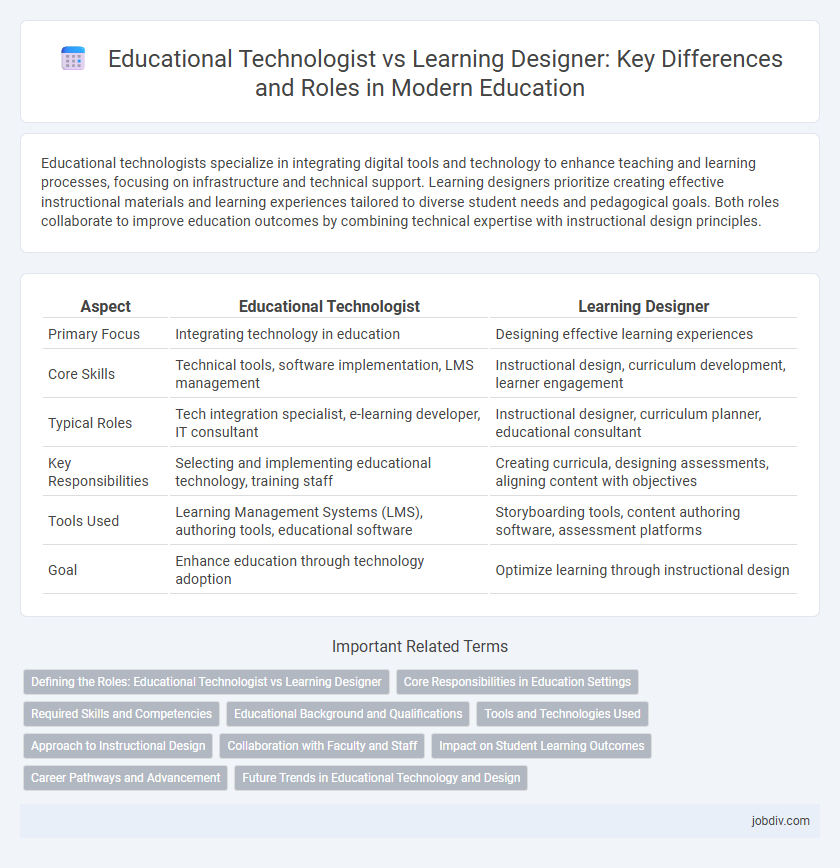Educational technologists specialize in integrating digital tools and technology to enhance teaching and learning processes, focusing on infrastructure and technical support. Learning designers prioritize creating effective instructional materials and learning experiences tailored to diverse student needs and pedagogical goals. Both roles collaborate to improve education outcomes by combining technical expertise with instructional design principles.
Table of Comparison
| Aspect | Educational Technologist | Learning Designer |
|---|---|---|
| Primary Focus | Integrating technology in education | Designing effective learning experiences |
| Core Skills | Technical tools, software implementation, LMS management | Instructional design, curriculum development, learner engagement |
| Typical Roles | Tech integration specialist, e-learning developer, IT consultant | Instructional designer, curriculum planner, educational consultant |
| Key Responsibilities | Selecting and implementing educational technology, training staff | Creating curricula, designing assessments, aligning content with objectives |
| Tools Used | Learning Management Systems (LMS), authoring tools, educational software | Storyboarding tools, content authoring software, assessment platforms |
| Goal | Enhance education through technology adoption | Optimize learning through instructional design |
Defining the Roles: Educational Technologist vs Learning Designer
An Educational Technologist specializes in integrating and managing technology tools to improve teaching and learning processes, focusing on hardware, software, and digital infrastructure. A Learning Designer centers on creating engaging, effective instructional content and experiences by applying pedagogical theories and learner-centered design principles. Both roles collaborate to enhance educational outcomes, but the Educational Technologist emphasizes technical implementation while the Learning Designer prioritizes curriculum design and learner engagement.
Core Responsibilities in Education Settings
Educational technologists focus on integrating and managing technology tools to enhance teaching and learning processes, ensuring effective adoption and maintenance of digital resources. Learning designers specialize in creating instructional materials and curricula based on pedagogical theories and learner needs to optimize educational outcomes. Both roles collaborate to improve educational experiences by combining technological infrastructure with innovative instructional design strategies.
Required Skills and Competencies
Educational Technologists require expertise in digital tools integration, instructional design software, and technical troubleshooting to enhance learning environments. Learning Designers emphasize curriculum development, learner analysis, and pedagogical strategies to create effective educational experiences. Both roles demand strong communication skills, project management abilities, and a deep understanding of learning theories.
Educational Background and Qualifications
Educational Technologists typically hold degrees in educational technology, instructional design, or related fields, emphasizing technical skills and integration of digital tools in learning environments. Learning Designers often possess backgrounds in education, cognitive science, or curriculum development, focusing on pedagogical theories and learner-centered design. Both roles benefit from certifications in e-learning software, but Learning Designers may require more expertise in curriculum standards and assessment strategies.
Tools and Technologies Used
Educational Technologists specialize in integrating and managing digital platforms such as Learning Management Systems (LMS), virtual classrooms, and educational software to enhance teaching and learning processes. Learning Designers focus on using authoring tools like Articulate Storyline, Adobe Captivate, and interactive multimedia resources to create engaging instructional materials and course content. Both roles leverage data analytics and adaptive learning technologies to personalize education and improve learner outcomes.
Approach to Instructional Design
Educational Technologists primarily focus on integrating technology tools to enhance instructional delivery, leveraging software and hardware to support learning environments. Learning Designers emphasize creating pedagogically sound content and experiences, applying theories of learning to structure curriculum and activities that maximize engagement and comprehension. Both roles collaborate to ensure technology effectively aligns with instructional goals, but their core approach differs: technologists center on technological implementation, while designers prioritize learning strategy and user experience.
Collaboration with Faculty and Staff
Educational Technologists specialize in integrating digital tools and platforms to enhance teaching methodologies, working closely with faculty to implement technology-driven solutions that align with course objectives. Learning Designers focus on curriculum development and pedagogical strategies, collaborating with staff and instructors to create engaging, learner-centered experiences that improve knowledge retention. Both roles require strong communication and teamwork skills to effectively support educators and optimize student learning outcomes within academic institutions.
Impact on Student Learning Outcomes
Educational technologists leverage digital tools and multimedia resources to create interactive learning environments that enhance student engagement and retention. Learning designers focus on structuring curriculum and assessment strategies based on pedagogical theories to optimize comprehension and knowledge application. Both roles directly contribute to improved student learning outcomes by integrating technology with evidence-based instructional design.
Career Pathways and Advancement
Educational technologists typically focus on integrating digital tools and technologies to enhance learning experiences, with career pathways often leading to roles such as instructional coordinators or technology consultants. Learning designers emphasize curriculum development and pedagogical strategies, progressing toward positions like curriculum specialists or training managers. Both career paths offer opportunities for advancement through gaining expertise in e-learning systems, data analytics, and educational research methodologies.
Future Trends in Educational Technology and Design
Educational technologists focus on integrating emerging technologies like AI and AR to enhance learning environments, while learning designers prioritize creating adaptive and personalized curriculum experiences driven by data analytics and learner feedback. Future trends emphasize the convergence of immersive technologies, such as virtual reality, with adaptive learning systems to improve engagement and efficacy. Both roles increasingly rely on interdisciplinary skills to innovate educational models that support lifelong learning and digital literacy.
Educational Technologist vs Learning Designer Infographic

 jobdiv.com
jobdiv.com